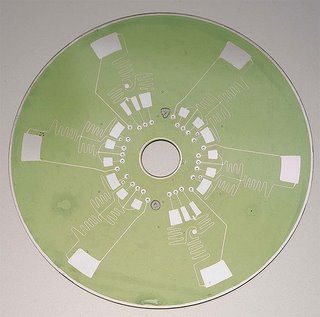Lab on a CD
Alright, this isn't exactly new (started sometime in the late 90s or early 2000s), and I can't explain it that well because it's way out of my area, but it's still pretty cool and the non-chemists might not have heard anything about it.

They call it a "Lab on a CD." Load the sample in the little wells closest to the hole in the middle. It only takes a few microliters or so. All of the rectangular-looking blank spaces are little reservoirs for reagents, standards, etc. The teeny little zigzags are channels for the liquids to travel through. I might be wrong about this, but I think the idea is for most of the analyses done on a lab-on-a-CD to be colorimetric. If you're familiar with discrete analyzers[1], most of that is colorimetric as well. Meaning...you take the sample and add a reagent that changes color in the presence of the target analyte. Then, you just use Beer's law[2] to determine the concentration of the analyte in the sample.
How do you use a lab-on-a-CD? A lot like you use a regular CD. It spins, and the centrifugal force makes the liquids flow. Pretty simple. Using such tiny volumes of sample means it's great for biological stuff.
Like I said, I don't do microfluidics, so this is oversimplified at best.[3] A few people doing research in this area are Dr. Marc Madou and Dr. Sylvia Daunert.
[1] After I graduate and am gainfully employed (something I am not looking forward to), I am SO posting a video of the discrete actually running! It's pretty cool.
[2] Beer's law is very disappointing, despite its utility. It sounds much more exciting than it actually is.
[3] Please oh please correct me where I am wrong.

1 comment:
Here is a nice example of bio-stuff on CD.
Molecular screening on a compact disc.
Org. Biomol. Chem. 2003 Sep 21;1(18):3244-9.
By the famous J.J. La Clair.
http://www.rsc.org/publishing/journals/OB/article.asp?doi=b306391g
Post a Comment